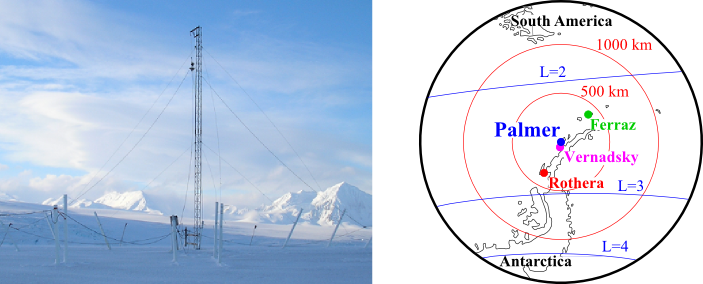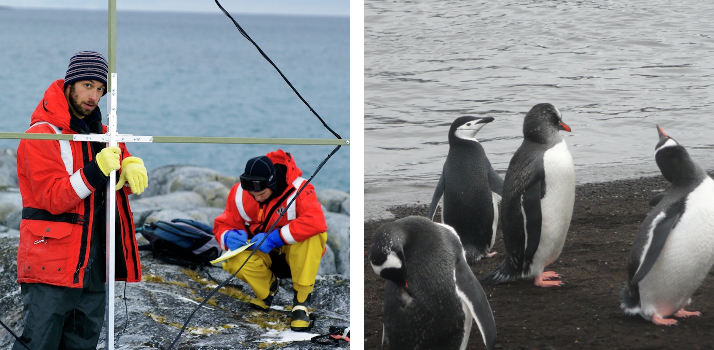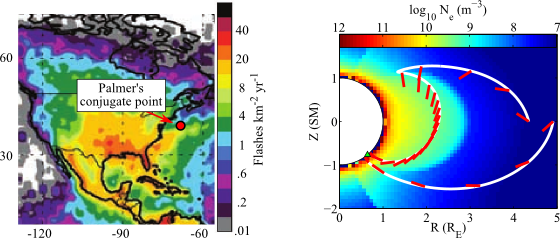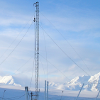Useful Links
10-second spectrograms
from Palmer, updated every minute.
24-hour summary spectrograms, updated daily.
10-second spectrograms
from Palmer, updated every minute.
24-hour summary spectrograms, updated daily.
Online data availability
from recent and past years.
Download raw and narrowband data
from Palmer station, and other Stanford ELF/VLF stations.
Past trip reports
from students who have performed annual maintenance at Palmer station.
Palmer Station Receiver and Data
Palmer Station, shown in Figure 1, is located on Anvers Island, near the tip of the Antarctic peninsula, at 64.77![]() S, 64.05
S, 64.05![]() W, with IGRF geomagnetic parameters of L = 2.4, 50
W, with IGRF geomagnetic parameters of L = 2.4, 50![]() S geomagnetic latitude. The Palmer VLF receiver records broadband VLF data at 100 kilosamples per second using two cross-loop magnetic field antennas, with 96 dB of dynamic range sensitivity, and is capable of measuring signals on the order of a femtotesla (
S geomagnetic latitude. The Palmer VLF receiver records broadband VLF data at 100 kilosamples per second using two cross-loop magnetic field antennas, with 96 dB of dynamic range sensitivity, and is capable of measuring signals on the order of a femtotesla (![]() tesla). Due to its remoteness from anthropogenic electromagnetic noise sources, Palmer Station is one of the most electromagnetically quiet ELF/VLF receiving sites in the world.
tesla). Due to its remoteness from anthropogenic electromagnetic noise sources, Palmer Station is one of the most electromagnetically quiet ELF/VLF receiving sites in the world.

|
A large amount of data is recorded at Palmer annually. Palmer records data 24 hours per day, 7 days per week, at two bytes per sample, 100 kilosamples per second, on two orthogonal channels. The total annual data volume is 12.6 terabytes (TB). Because of limited telemetry from Palmer, this data cannot be transfered back to Stanford via the Internet. Instead, external USB hard drives of size 1 TB or greater are shipped back and forth via Stanford and Palmer. The data is then loaded onto the Stanford VLF data server, where it is made available to the worldwide community, along with data from many other remote sites, at http://vlf.stanford.edu.
The Palmer receiver is maintained annually by students from the Stanford VLF group (Figure 2). Students are responsible for calibrating the receiver, replacing old equipment, and ensuring that the antenna is remains accessible and operational during changing antarctic conditions.

|
Science at Palmer Station
One of the major outstanding scientific problems in the field of heliophysics is understanding and quantifying the dominant source and loss processes that contribute to the variability of relativistic electron populations in the Earth’s radiation belts. Whistler mode waves play a major role in controlling the dynamic evolution of these particle populations. These waves are regularly able to penetrate the ionosphere to be detected at ground-based stations like Palmer.
Three distinct types of magnetospheric emissions are observed at Palmer: chorus, hiss, and whistlers. Examples of these emissions, received at Palmer, are shown in Figure 3. Chorus is generated in the Earth’s magnetosphere, beyond the plasmasphere, and can influence both the acceleration [Baker et al., 2004; Horne et al., 2005; Spasojevic and Inan, 2005] and loss [O’Brien et al., 2004; Inan et al., 1992; Lorentzen et al., 2001] of energetic particles. Hiss is generated within the plasmasphere, and is one of the main scattering agents that maintains the slot region between the inner and outer radiation belts [Abel and Thorne, 1998; Lyons and Thorne, 1973]. Whistlers are generated from terrestrial lightning near the surface of the Earth, and are also important contributors to energetic electron scattering in the slot region of the radiation belts [Abel and Thorne, 1998; Bortnik et al., 2002].

|
Chorus and whistlers have separately been proposed to be important sources of hiss. The original suggestions that lightning was a source of hiss, made some time ago by Sonwalkar and Inan [1989] and Draganov et al. [1992], have recently sparked competing ideas [Green et al., 2005; Meredith et al., 2006] about the frequency range and significance of lightning control over plasmaspheric hiss. Palmer’s conjugate point near the East coast of the United States, shown in the left panel of Figure 4, allows Palmer the unique opportunity to observe hiss that is generated from North American lightning, one of the major sources of lightning worldwide. By searching for correlations between (1) lightning in the vicinity of Palmer’s conjugate point and (2) hiss observed at Palmer, one can determine which populations of lightning contribute to hiss, and under what geomagnetic circumstances. The possibility of chorus as a source of hiss [Bortnik et al., 2008; Santolík et al., 2006; Parrot et al., 2004] may also be tested using Palmer data. The preponderance of simultaneous observations of chorus and hiss at Palmer [Golden et al., 2009] allows examination of the relationship between these two emissions.

|
Ground-based measurements of magnetospheric emissions have several significant advantages over space-based measurements, including cost, data throughput, and the controllability of the measurement location. In particular, the dearth of space-based wave measurements in the inner magnetosphere during the previous peak of the solar cycle underscores the importance of long-term ground-based observations. However, the main disadvantage of ground-based measurements is that they are limited to observing the subset of magnetospheric emissions that penetrate through the ionosphere to the ground [e.g. Sonwalkar, 1995, pp 424-425]. Thus in order to make inferences about the implications of Palmer observations, it is critical to understand which wave populations are observable at Palmer. This can be accomplished by triangulating the ionospheric penetration points of the waves using measurements from other stations on the Antarctic peninsula, such as Rothera (UK), Ferraz (Brazil) and Vernadsky (Ukraine) (Figure 1). Once the ionospheric penetration points are known, one can then perform reverse raytracing on rays that begin at that point, such as in the right panel of Figure 4. This procedure allows us to interpret received waves in the context of their generation region, and the regions in which they interact with energetic particles.
Acknowledgements
ELF/VLF research at Palmer Station is supported by the National Science Foundation Office of Polar Programs.
Bibliography
Abel, B., and R. M. Thorne (1998), Electron scattering loss in Earth’s
inner magnetosphere 1. Dominant physical processes, J. Geophys.
Res., 103, 2385-2396, doi:
rm10.1029/97JA02919.
Baker, D. N., S. G. Kanekal, X. Li, S. P. Monk, J. Goldstein, and
J. L. Burch (2004), An extreme distortion of the Van Allen belt arising
from the `Hallowe’en’ solar storm in 2003, Nature, 432,
878-881, doi:
rm10.1038/nature03116.
Bortnik, J., U. S. Inan, and T. F. Bell (2002), L dependence of
energetic electron precipitation driven by magnetospherically reflecting
whistler waves, J. Geophys. Res. (Space Phys.), 107, 1150,
doi:
rm10.1029/2001JA000303.
Bortnik, J., R. M. Thorne, and N. P. Meredith (2008), The unexpected
origin of plasmaspheric hiss from discrete chorus emissions,
Nature, 452, 62-66, doi:
rm10.1038/nature06741.
Draganov, A. B., U. S. Inan, V. S. Sonwalkar, and T. F. Bell (1992),
Magnetospherically reflected whistlers as a source of plasmaspheric hiss,
Geophys. Res. Lett., 19, 233-236.
Golden, D. I., M. Spasojevic, and U. S. Inan (2009), Diurnal dependence
of ELF/VLF hiss and its relation to chorus at L = 2.4, J. Geophys.
Res. (Space Phys.), 114, 5212, doi:
rm10.1029/2008JA013946.
Green, J. L., S. Boardsen, L. Garcia, W. W. L. Taylor, S. F. Fung,
and B. W. Reinisch (2005), On the origin of whistler mode radiation in the
plasmasphere, J. Geophys. Res. (Space Phys.), 110, 3201,
doi:
rm10.1029/2004JA010495.
Horne, R. B., et al. (2005), Wave acceleration of electrons in the Van Allen
radiation belts, Nature, 437, 227-230,
doi:
rm10.1038/nature03939.
Inan, U. S., Y. T. Chiu, and G. T. Davidson (1992), Whistler-mode chorus
and morningside aurorae, Geophys. Res. Lett., 19,
653-656, doi:
rm10.1029/92GL00402.
Lorentzen, K. R., J. B. Blake, U. S. Inan, and J. Bortnik (2001),
Observations of relativistic electron microbursts in association with VLF
chorus, J. Geophys. Res., 106, 6017-6028,
doi:
rm10.1029/2000JA003018.
Lyons, L. R., and R. M. Thorne (1973), Equilibrium Structure of Radiation
Belt Electrons, J. Geophys. Res., 78, 2142-2149,
doi:
rm10.1029/JA078i013p02142.
Meredith, N. P., R. B. Horne, M. A. Clilverd, D. Horsfall, R. M.
Thorne, and R. R. Anderson (2006), Origins of plasmaspheric hiss,
J. Geophys. Res. (Space Phys.), 111, 9217,
doi:
rm10.1029/2006JA011707.
O’Brien, T. P., M. D. Looper, and J. B. Blake (2004), Quantification of
relativistic electron microburst losses during the GEM storms,
Geophys. Res. Lett., 31, 4802, doi:
rm10.1029/2003GL018621.
Parrot, M., O. Santolík, D. Gurnett, J. Pickett, and
N. Cornilleau-Wehrlin (2004), Characteristics of magnetospherically
reflected chorus waves observed by CLUSTER, Ann. Geophys.,
22, 2597-2606.
Santolík, O., J. Chum, M. Parrot, D. A. Gurnett, J. S. Pickett,
and N. Cornilleau-Wehrlin (2006), Propagation of whistler mode chorus to
low altitudes: Spacecraft observations of structured ELF hiss, J.
Geophys. Res. (Space Phys.), 111, 10,208,
doi:
rm10.1029/2005JA011462.
Sonwalkar, V. S. (1995), Handbook of Atmospheric Electrodynamics,
vol. II, 407-460 pp., CRC Press.
Sonwalkar, V. S., and U. S. Inan (1989), Lightning as an embryonic source
of VLF hiss, J. Geophys. Res., 94, 6986-6994.
Spasojevic, M., and U. S. Inan (2005), Ground based VLF observations near
L = 2.5 during the Halloween 2003 storm, Geophys. Res. Lett.,
32, 21,103, doi:
rm10.1029/2005GL024377.
